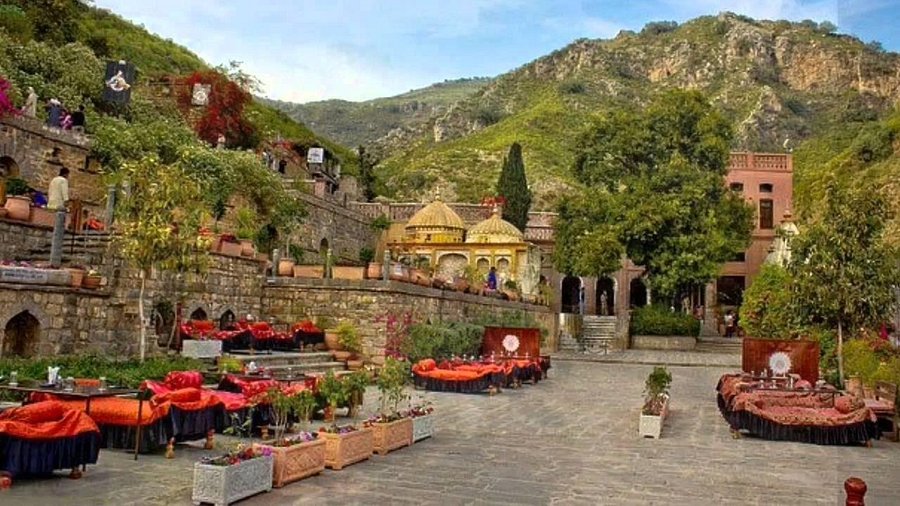Introduction
Saidpur Village is a historic and cultural site located on the northern slopes of the Margalla Hills, just outside Islamabad, Pakistan. This picturesque village is one of the oldest settlements in the region and offers a unique blend of traditional village life and modern tourism. Over the years, Saidpur has become a popular destination for both locals and tourists due to its scenic beauty, rich history, and cultural significance.
History and Significance
Saidpur Village dates back several centuries and was originally a Hindu settlement. It has a rich cultural and historical heritage, having witnessed the passage of various civilizations, including the Mughal and Sikh periods. The village was named after “Saidpur,” with “Said” meaning “holy” and “Pur” meaning “village” in the local language. This historical village was home to diverse communities, including Hindus, Sikhs, and Muslims, making it a melting pot of different cultures.
The village gained much of its prominence during the Mughal era, but over time, it fell into relative obscurity. However, in recent years, the government and private investors have revitalized Saidpur Village, transforming it into a major tourist destination that retains its historical charm while embracing modernity.
Cultural and Architectural Features
The most striking feature of Saidpur Village is its mix of old and new architecture. Traditional stone houses, narrow alleyways, and ancient temples and mosques coexist with modern restaurants and cafes, giving the village a unique character. The old village structures have been carefully preserved, allowing visitors to experience a glimpse of the past.
Some key highlights of Saidpur Village include:
Historical Temples and Mosques: The village has several religious structures, including a Hindu temple and a mosque, reflecting the area’s diverse religious history. These buildings offer a sense of the spiritual life that existed in the region for centuries.
Traditional Architecture: The stone houses, narrow streets, and old wells give visitors a sense of what life was like in the past. The architecture is simple yet beautiful, offering a sharp contrast to the modernity seen in the rest of Islamabad.
Restaurants and Cafes: In recent years, Saidpur has been developed as a cultural and dining hub. Several restaurants and cafes have opened in the area, serving traditional Pakistani food, local delicacies, and international cuisine. Many of these eateries are designed with traditional and rustic themes, providing an immersive dining experience.
Saidpur Model Village Project: As part of the efforts to preserve the village’s historical integrity, the government introduced the Saidpur Model Village Project, which aims to maintain the traditional look of the village while promoting sustainable tourism.
Activities and Attractions
Cultural Walks: Visitors can take a stroll through the village’s narrow streets to admire the traditional architecture and experience the local way of life. Walking tours are available, where guides explain the village’s history, culture, and architecture.
Dining Experience: The village has become famous for its cultural restaurants, such as “Monal Restaurant,” which offers breathtaking views of the surrounding hills and the city. Dining here provides both a culinary delight and a scenic experience, especially at sunset.
Hiking and Nature Trails: Saidpur Village is located close to the Margalla Hills National Park, which offers various hiking trails. Visitors can hike up the nearby hills to enjoy panoramic views of Islamabad and Rawalpindi.
Photography and Scenic Views: The village’s blend of natural beauty and historic architecture provides excellent opportunities for photography. The backdrop of the Margalla Hills, combined with the village’s quaint charm, makes it a photographer’s paradise.
Modern Developments and Tourism.
While Saidpur Village has retained much of its historical and cultural character, recent developments have aimed at making it more accessible to tourists. The village now boasts well-maintained pathways, clean facilities, and a developed infrastructure, making it a safe and enjoyable place to visit. The government has also worked to promote local crafts and products, encouraging artisans from the area to showcase their work in small stalls and shops.
The revitalization of Saidpur Village has made it a popular spot for both day-trippers from Islamabad and international tourists. It serves as an excellent example of how traditional and modern elements can coexist to create a vibrant, dynamic cultural space.
Conclusion
Saidpur Village – A timeless testament to Pakistan’s cultural heritage, where history seamlessly blends with modern tourism. Its rich past, scenic beauty, and vibrant atmosphere make it an ideal destination for those seeking to experience the history, culture, and natural beauty of Islamabad. Whether for a leisurely walk through the village’s alleys, a delightful meal at a traditional restaurant, or a hike up the nearby hills, Saidpur Village offers something for everyone.




 Uncategorized7 years ago
Uncategorized7 years ago
 Uncategorized7 years ago
Uncategorized7 years ago
 Uncategorized7 years ago
Uncategorized7 years ago
 Uncategorized7 years ago
Uncategorized7 years ago
 Uncategorized7 years ago
Uncategorized7 years ago
 Uncategorized7 years ago
Uncategorized7 years ago
 Peshawar7 years ago
Peshawar7 years ago
 Uncategorized7 years ago
Uncategorized7 years ago




